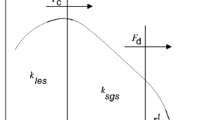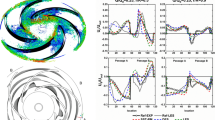Abstract
A solver is developed for time-accurate computations of viscous flows based on the conception of Newton's method. A set of pseudo-time derivatives are added into governing equations and the discretized system is solved using GMRES algorithm. Due to some special properties of GMRES algorithm, the solution procedure for unsteady flows could be regarded as a kind of Newton iteration. The physical-time derivatives of governing equations are discretized using two different approaches, i.e., 3-point Euler backward, and Crank-Nicolson formulas, both with 2nd-order accuracy in time but with different truncation errors. The turbulent eddy viscosity is calculated by using a version of Spalart-Allmaras one-equation model modified by authors for turbulent flows. Two cases of unsteady viscous flow are investigated to validate and assess the solver, i.e., low Reynolds number flow around a row of cylinders and transonic bi-circular-arc airfoil flow featuring the vortex shedding and shock buffeting problems, respectively. Meanwhile, comparisons between the two schemes of time-derivative discretizations are carefully made. It is illustrated that the developed unsteady flow solver shows a considerable efficiency and the Crank-Nicolson scheme gives better results compared with Euler method.
Similar content being viewed by others
References
Jameson A. Time dependent calculations using multigrid, with applications to unsteady flows past airfoils and wings. AIAA Paper 91-1596, 1991
Arnone A, Liou MS, Povinelli LA. Integration of Navier-Stokes equations using dual time stepping and a multigrid method.AIAA Journal, 1995, 33(6): 985–990
Saad Y, Schultz MH. GMRES: A generalized minimal residual algorithm for solving nonsymmetric linear systems.SIAM J On Scientific and Statistical Computing, 1986, 7(3): 856–869
Ning F, Xu L. Application of GMRES algorithm in the predictions of two-dimensional inviscous steady flows.Chinese J Comput Phys, 2000, 17(5): 537–547
Ning F, Xu L. Application of GMRES algorithm in the predictions of two-dimensional turbulent steady flows.Acta Mechanica Sinica, 2001, 33(4): 442–451
Spalart PR, Allmaras SR. A one-equation turbulence model for aerodynamic flows.La Recherche Aérospatiale, 1994, 1: 5–21
Ning F, Xu L. Numerical investigation of transonic compressor rotor flow using an implicit 3D flow solver with one-equation spalart-allmaras turbulence model. ASME Paper 2001-GT-0359, 2001
Wada Y, Liou MS. A flux splitting scheme with high-resolution and robustness for discontinuities. AIAA Paper 94-0083, 1994
Van Leer B. Towards the ultimate conservation difference scheme: V. A second-order sequel to Godunov's method.J Comput Phys, 1979, 32: 101–136
Chakravarthy SR. High resolution upwind formulations for the Navier-Stokes equations. Computational Fluid Dynamics, Von Kármán Inst, Lecture Series, 1988
Meijerink JA, Van der Vorst HA. Guidelines for the usage of incomplete decompositions in solving sets of linear equations as they occur.J Comput Phys, 1981, 44: 134–155
Nielsen EJ. Application of Newton-Krylov methodology to a three-dimensional unstructured Euler code. AIAA Paper 95-1733, 1995
McDevitt JB, Levy LL, Deiwert GS. Transonic flow about a thick circular-arc airfoil.AIAA Journal, 1976, 14(5): 606–613
Seegmiller HL, Marvin JG, Levy LL. Steady and unsteady transonic flow.AIAA Journal, 1978, 16(12): 1262–1270
Author information
Authors and Affiliations
Additional information
The project supported by the National Natural Science Foundation of China (59525612).
Rights and permissions
About this article
Cite this article
Fangfei, N., Liping, X. A solver using Newton's method for unsteady viscous flows. Acta Mech Sinica 19, 220–227 (2003). https://doi.org/10.1007/BF02484483
Received:
Revised:
Issue Date:
DOI: https://doi.org/10.1007/BF02484483




